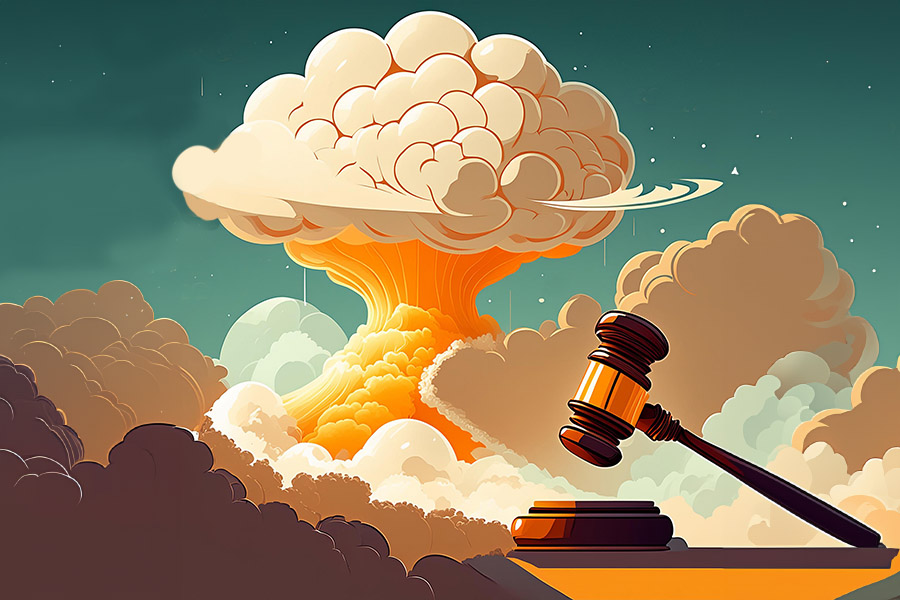April 20, 2012 Grand Hyatt Hotel, New York City
» Download the full PDF report (includes transcript)
How does, and how should, international humanitarian law (IHL) governing the conduct of warfare apply to nuclear weapons? On April 20, 2012, three highly qualified speakers addressed that question in a well-attended program of the annual meeting of the International Law Section of the American Bar Association. The program was organized by Lawyers Committee on Nuclear Policy (LCNP) and Global Security Institute and sponsored by the section’s National Security Committee.
Audio of the session is available in two parts:
Part I
Introducing the topic, moderator Dr. John Burroughs, LCNP Executive Director, noted an important recent development, an innovative provision adopted by the 2010 Nuclear Non-Proliferation Treaty (NPT) Review Conference. In the Final Document, the Conference “expresses its deep concern at the catastrophic humanitarian consequences of any use of nuclear weapons, and reaffirms the need for all states at all times to comply with applicable international law, including international humanitarian law.”
 |
|
Ambasssador Cabactulan
|
The first speaker, Ambassador Libran Cabactulan, the Philippines’ Permanent Representative to the United Nations, served as President of the 2010 NPT Review Conference. He said that there is a link between the NPT and the illegality of nuclear weapons; the NPT came into existence with the objective of eliminating nuclear weapons “precisely because the weapons’ destructive force is inherently inhuman. The NPT preamble makes this abundantly clear.” For the first time in the history of the NPT, the 2010 Final Document specifically invoked international humanitarian law. The provision was placed in the disarmament portion of the conclusions and recommendations. In his view, “taken as a whole” it is a “major step” in reinforcing the legal prohibition of nuclear weapons and a “powerful political statement on the nexus between nuclear disarmament and IHL.”
Ambassador Cabactulan also presented the Philippines’ longstanding views on the subject, stating: “The Philippines strongly believes that nuclear weapons are strictly prohibited by customary and conventional IHL. No amount of legal hairsplitting or operational obfuscation can change the fact that of all the weapons ever conceived by the mind of man, nuclear weapons are inherently indiscriminate, far beyond proportionality, cause unimaginable unnecessary suffering, and are inescapably harmful to the environment. It is a weapon where the notion of control is meaningless and the idea of military necessity is absurd. Nuclear weapons are the apex of man’s genius at finding ways to destroy his fellow human beings. Using that same genius to come up with hypothetical scenarios where nuclear weapons would not violate IHL to us is simply allowing the exception to lead the rule by the nose. But more importantly assertion of exceptions should be seen as proving the rule and that rule must find life in law either by treaty or court opinion.”
The next speaker, Charles J. Moxley, Jr., a mediator and arbitrator, is an adjunct professor at Fordham University School of Law and author of International Law and Nuclear Weapons in the Post Cold War World (Austin & Winfield, 2000). Professor Moxley concentrated on assessment of the lawfulness of use of nuclear weapons under rules of IHL as to discrimination, proportionality and necessity, and a corollary requirement of controllability, set forth in the US armed services manuals on the law of armed conflict. A 2010 US Army manual states that discrimination “requires parties to a conflict to engage only in military operations the effects of which distinguish between the civilian population (or individual civilians not taking part in hostilities) and combatant forces, directing the application of force solely against the latter.” Given that the effects of nuclear explosions include a huge blast, electromagnetic pulses, and radiation, Professor Moxley asked whether nuclear weapons can possibly meet this standard which calls for controllability of effects. “The answer,” he said, “seems evident.” It is also impossible to ensure that a nuclear attack is limited to the level of violence necessary and proportionate to achieve legitimate military ends in accordance with standards set out in the manuals.
In principle, Professor Moxley said, the United States accepts that IHL applies to nuclear weapons; this is acknowledged in the manuals and in the US argument to the International Court of Justice in the nuclear weapons case. In practice, however, the United States does not apply but rather ignores the rules. That is so in the Nuclear Posture Review, which does not mention IHL, in training, in weapons development and possession, and most importantly in relying on the policy of nuclear deterrence, under which nuclear weapons in large numbers remain continuously ready for launch as during the Cold War. Regarding that policy, Professor Moxley noted that in its 1996 advisory opinion, the International Court of Justice stated that it is unlawful to threaten use of a weapon which would be unlawful to use. He closed by asking: “Is it not evident that our policy of deterrence is unlawful if the actual use would be unlawful?”
 |
|
Professor Gary Solis
|
The final speaker, Gary Solis, for six years headed the law of war program at the US Military Academy at West Point, is currently an adjunct professor at Georgetown Law and a lecturer at George Washington University Law School, and is the author The Law of Armed Conflict: International Humanitarian Law in War (Cambridge University Press, 2010). Professor Solis explained that in directives and in training at all levels, the US military takes the law of armed conflict quite seriously. West Point and Annapolis, the two military academies he is familiar with, stress the law of armed conflict in instruction generally and now have dedicated courses on the subject. He said: “What about war crimes like Abu Ghraib, Haditha, Hamdaniya, the Thrill Kills of Third Stryker Brigade, Staff Sergeant Bales, and so on? No law will deter the lawless. Actually, it is a wonder there are not more war crimes than there are. When you send a million 18 and 19 year olds into a combat zone with high powered weapons, it is inevitable that bad things are going to happen. That’s not cynicism so much as a recognition of reality. But for every egregious war crime that you can name, there are 6, 8, 10, 12 court-martial convictions for violations of the law of armed conflict.”
However, Professor Solis continued, “there is a glaring anomaly in America’s admirable resolve to observe and enforce the law of war. There is one law of war topic that is not taught; that is not the subject of Department of Defense directives and orders; that is overlooked by military education directives and uniformed education and classroom discussions; and that is nuclear weapons, their lawful, and more significantly, their potentially unlawful use.” Nor is the question addressed in military law journals. Professor Solis concluded: “As lawyers we know what the law is. The absence of discussion in Department of Defense orders and instructions and regulations in regard to nuclear weapons allows for both tactical and strategic wiggle room.”
The Program Co-Chairs were John Harrington, Co-Chair of the National Security Committee of the ABA International Law Section, and Jonathan Granoff, President of the Global Security Institute and Co-Chair of the ABA International Law Section Blue Ribbon Task Force on Nuclear Non-Proliferation. In opening the program, Mr. Harrington observed that the discourse in the section has largely concerned nuclear arms control treaties. IHL, in contrast, applies to all weapons, in all countries; it is a powerful body of law.
Responding to the speakers, Mr. Granoff said that “the law seems to be quite clear here: You cannot bring nuclear weapons into compliance with the standards of IHL; the two are simply incompatible.” However, “there seems to be collective psychological denial” that nuclear weapons are being brandished. But “some people are awake,” and there are road maps with practical and reasonable steps for coming into compliance with the law, both IHL and the “unequivocal undertaking” under the NPT “to accomplish the total elimination of nuclear arsenals.” What is needed is passion and advocacy, and lawyers have the necessary skills. “These are legal issues,” Mr. Granoff said, “and I believe that it is our responsibility to take this on.”
Further Reading on Law and Nuclear Weapons
Charles J. Moxley, Jr., John Burroughs, and Jonathan Granoff, “Nuclear Weapons and Compliance with International Humanitarian Law and the Nuclear Non-Proliferation Treaty,” 34 Fordham International Law Journal (April 2011, No. 4)
Charles J. Moxley, Jr., “Obama’s Nuclear Posture Review,” 34 Fordham International Law Journal (April 2011, No. 4)
Dean Granoff and Jonathan Granoff, “International humanitarian law and nuclear weapons: irreconcilable differences,” Bulletin of the Atomic Scientists (November/December 2011)
Nuclear Abolition Forum (2011, No. 1), “International Humanitarian Law and Nuclear Weapons: Examining the Humanitarian Approach to Nuclear Disarmament,” edited by John Burroughs
Jonathan Granoff is the President of the Global Security Institute, a representative to United Nations of the World Summits of Nobel Peace Laureates, a former Adjunct Professor of International Law at Widener University School of Law, and Senior Advisor to the Committee on National Security American Bar Association International Law Section.








